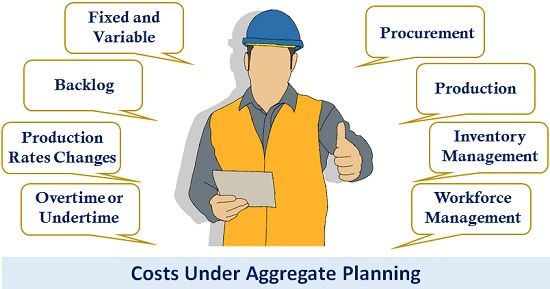Definition: Aggregate Planning in Operations Management determines production and resource allocation strategies to meet the uncertain and fluctuating future demand at minimum production cost for the Intermediate Time Horizon.
Here, the word ‘Aggregate‘ signifies the product lines and families. And ‘Planning‘ covers the series of activities to be taken in order to meet the expected demand.

In simple words, Aggregate Planning enables supply creation as per corresponding demand. It aligns the organizational resources in the direction of the Intermediate-Term Goals.
The process involves planning resources and achieving the organization’s long-term objectives. Therefore, organizations strive to match their supply with expected demand and remain profitable in the long run.
Following are the major decisions taken under Aggregate Planning:
- Workforce Decisions
- Inventory Decisions
- Production Rate
Content: Aggregate Planning in Operations Management
- What is Aggregate Production Planning?
- Objectives
- Need
- Nature
- Strategies
- Methods
- Steps
- Costs under Aggregate Planning
- Aggregate Planning for Services
- Master Production Scheduling (MPS)
- Problems in Aggregate Planning
- Example
- Conclusion
What is Aggregate Production Planning?
The mass production units prepare Strategic and Operational plans on an aggregate level to achieve their goals. We refer to these operational plans as Aggregate Production Plans.
Pre-requirements for the planning on an aggregate level:
- Demand forecast for the period
- Knowledge about the availability and scarcity of resources
- Costs of various alternatives
- Organizations’ practices and policies
Key decisions that are taken under Aggregate Planning:
- Technology Selection
- Capital Investments
- Location
- Personnel Policies
- Raw Material Policies
Objectives of Aggregate Planning
The goal behind making the strategic plans is to find an economical and excellent combination of resources. Some objectives of preparing an aggregate plan are:
- Cost Reduction
- Profits Maximize
- Minimize Inventory Investment
- Improving Customer Service and Post-Purchase Experience
- Reducing Production Rates
- Fewer changes in Workforce Levels
- Maximize use of Plant and Equipment
Need for Aggregate Operations Planning
The organizations need to plan their production/services due to following reasons:
- Demand Fluctuations: The demand for products and services keeps on changing for different reasons. Consequently, organizations plan their productions by Forecasting Future Demand and creating a sufficient supply thereof.
- Capacity Fluctuations: Besides fluctuating demand, the capacity and other resources also change every now and then. It can be an outcome of the changes in Working Days, Workforce, etc.
Nature of Aggregate Planning
The production managers use aggregate production plans to determine the series of actions to be taken in the near future. In addition, they consider the following parameters in mind while planning:
- Capability Planning and Performance Matrix
- Demand Forecasts and Actual Orders
- Resource Availability
Aggregate Planning Strategies
Following are the strategies that organizations can use for aggregate production planning. As per the need, the organizations can use a single or a combination of strategies.
Pure Strategies
In this, the organizations opt for a single strategy to meet the forecasted demand. These strategies may include:
- Managing inventory by the constant workforce
- Changing the size of the workforce
- Overtime Utilization
- Subcontracting
The above strategies are broadly classified into:
- Level Strategy: Here, capacity and employment remain constant. At the same time, managers make changes in the level of inventory in the organization. The organization may also have a Backlog or Backorder.
- Chase Strategy: It contrasts level strategy as the Inventory level remains constant here. However, the demand is met by hiring and firing the Workforce.
Mixed/Hybrid Strategies
To meet the forecasted demand at the least cost, the organizations use a combination of pure strategies. As these strategies are in combination, we refer to them as Hybrid or Mixed Strategies.
These strategies can help them in matching the supply effectively and efficiently. For Example – An organization may use Overtime Utilization strategies along with Subcontracting.
Methods of Aggregate Planning in Operations Management
The methods discussed below can be used to plan and evaluate the operations in the facilities:
Graphical Method
In this, we plot the demand and production capacities on the graph. After that, we identify the gap existing between estimated Demand and Production.
This method does not impact the costs, and cost data is not considered.
Heuristic Method
Here, the plan is based on the list of pure and mixed strategies yielding the least cost. And thus selecting the most cost-efficient suitable alternative.
Transportation model
The organizations can express the planning objective in the linear equation. So, one can solve complex aggregate problems with the help of Artificial Intelligence, Apps and Software.
Linear Programming
In this model of aggregate Planning, one can put all the variables in a linear programming model. It results in finding an economical alternative for the facilities.
Steps in Aggregate Planning
Following are the steps that one can follow during aggregate Planning:
- Estimate future demand for the Intermediate Period.
- Determine capacities of the facility like – Regular Time, Overtime, Sub-contracting, etc.
- Identify and Review departmental policies.
- Determine the relevant unit costs related to production.
- Develop and evaluate alternative plans.
- Select a plan with minimum cost.
Costs under Aggregate Planning
Cost is an important variable to be considered during aggregate Planning. The minor changes in demand lay a massive impact on the associated costs.

Managers can make certain assumptions about costs in the planning stage. But, in some cases, firms cannot draw any inferences.
Some of the costs that are relevant to Aggregate Planning in Operations Management are as follows:
- Procurement Costs
- Production Costs
- Inventory Management Costs
- Workforce Management Costs
- Overtime or Undertime Costs
- Cost of Changing Rate of Production Costs
- Backlog Costs
- Fixed and Variable Costs
Aggregate Planning for Services
Aggregate Planning for services differs from that of production. Because the services follow Make-to-Order rather than Make-to-Stock.
It aims to manage the high and low demand periods by utilizing the existing workforce to the fullest. It only makes aggregate plans about:
- The number of Manpower to meet the future requirement
- Smoothing the load of service rate
Challenges in Service Aggregate Planning
- We cannot keep services as Inventory
- Difficulty in forecasting demand for services
- Largely dependent on its human resources
Master Production Scheduling (MPS)
Master Production Scheduling is the focused product-wise schedule developed along with the aggregate plans. We refer to MPS as Disaggregation Planning as we split the major plan into small strategic plans.
These schedules provide an idea about the production volumes during various time horizons. Organizations can use the following techniques for Disaggregation:
- Cut-and-Fit Methods
- Mathematical Methods
- Heuristic Methods
Problems in Aggregate Planning
The overall concept of aggregate planning assumes that the forecasted demand is known. This is the strength and weakness of the approach at the same time. Some areas in which the organizations may face problems are as follows:
- Changes in production and workforce in different planning periods.
- The capability of the organizations to manage abrupt changes in demand.
- Difficulty in compiling capacities in an aggregate form.
Example
Suppose XYZ ltd. deals in Umbrella manufacturing. Its marketing team initiated market research for the 3rd Quarter. Thereafter, they concluded that there would be heavy rainfall in the coming months.
Normally they could manufacture 2000 Umbrellas per month and had 1000 pieces in stock. Therefore, they decided to increase the production and produce 1000 pieces more.
Consequently, he decided to hire more workers to meet the upcoming demand. The production manager instructed the workers to do overtime for this purpose. Finally, they could complete the production by the end of the month.
XYZ ltd. were able to supply Umbrellas to all its dealers and therefore earned handsome profits at the year’s end.
Conclusion
Aggregate Planning in Operations Management is developing, analyzing and managing the production. It focuses on matching capacity and resources at minimal costs.
Leave a Reply